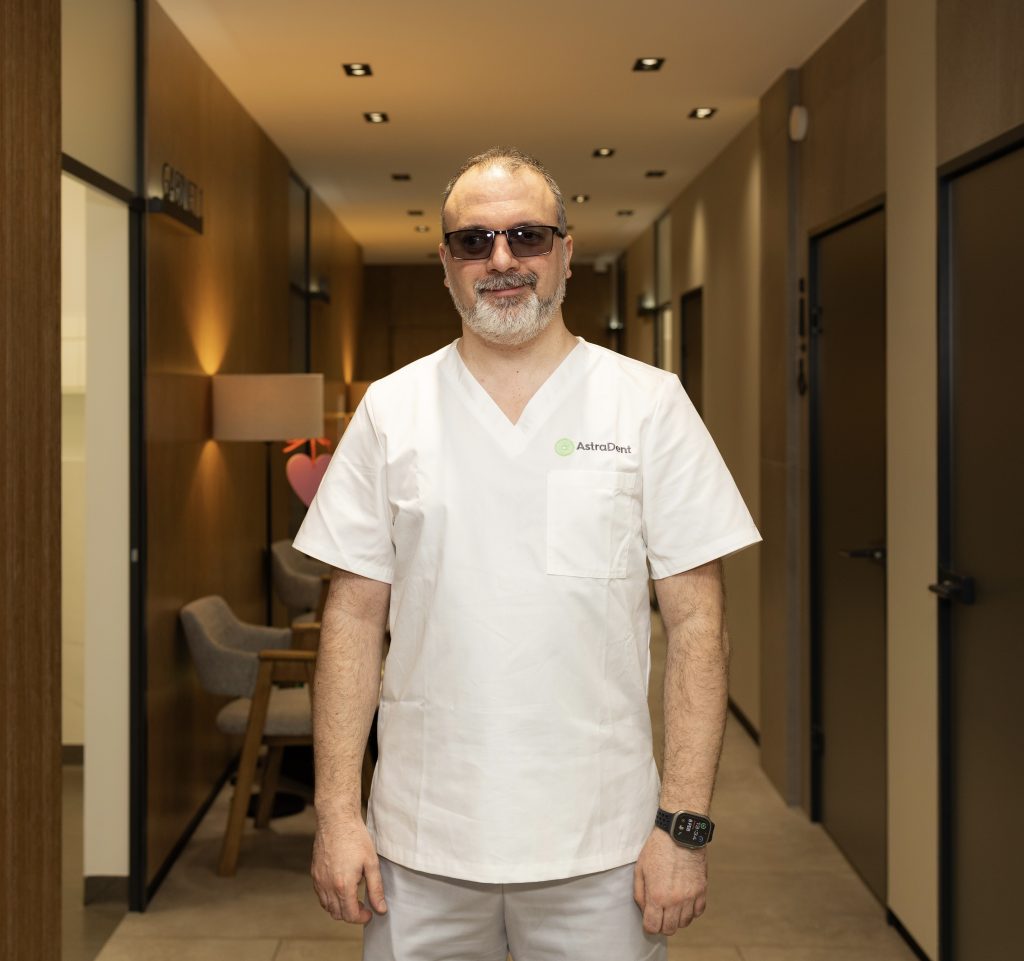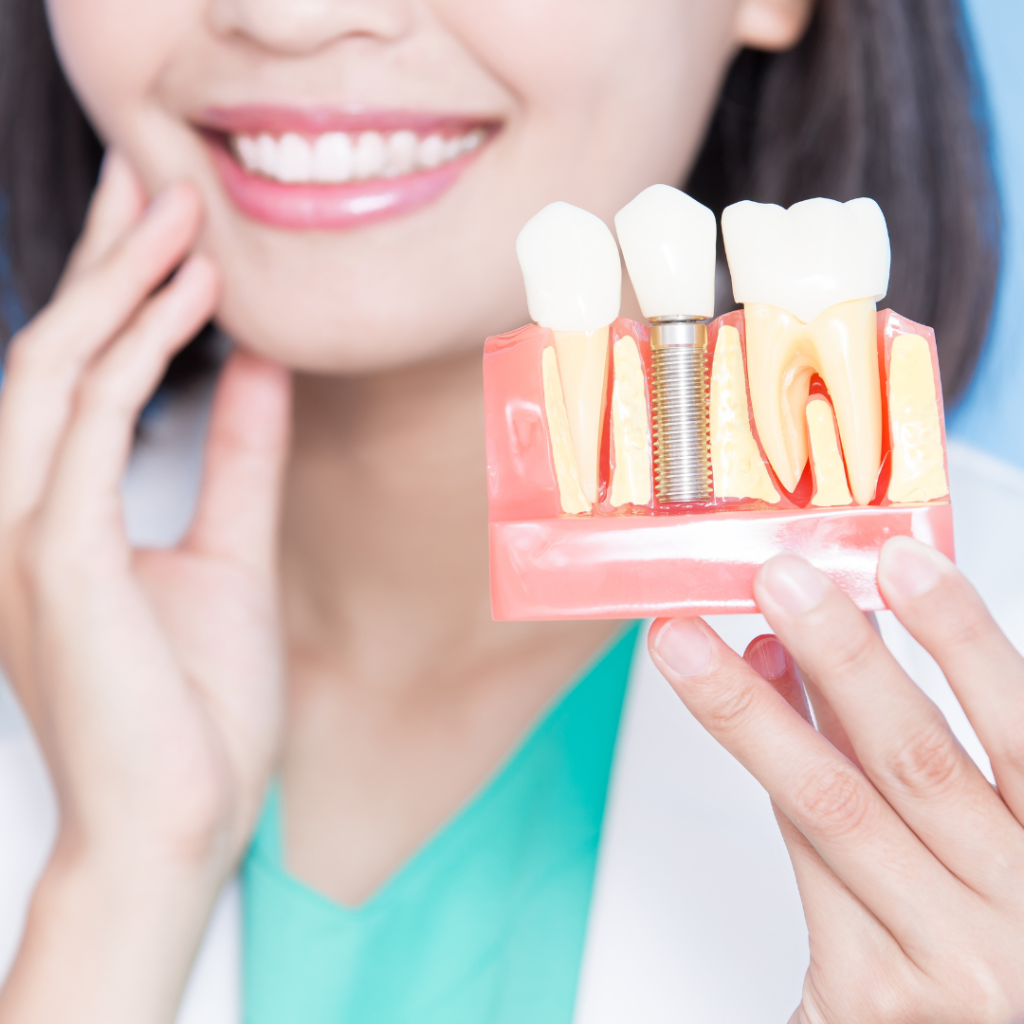TMJ dysfunction in Warsaw – get rid of pain and restore the natural function of the jaw
Temporomandibular joint dysfunction (TMJ) is a functional disorder of the coordinated work of the joint, chewing muscles and dentofacial system, which is manifested by pain, clicking, jaw displacement, and limitation of mouth opening. Normally, the TMJ provides mobility of the lower jaw in three planes – during chewing, speaking, swallowing and facial expressions. However, even a slight imbalance between the joint and muscles leads to noticeable discomfort.
Astra Dent specialists diagnose TMJ problems using digital radiography, jaw mobility analysis, muscle palpation, and functional testing using an articulator. A comprehensive approach allows us to identify initial disorders in the joint that the patient may not associate with TMJ, for example, frequent headaches, tinnitus, crunching when yawning. Timely referral to a specialist allows you to avoid complex treatment in the future and restore symmetrical, painless jaw function without medication.
Why do patients choose Astra Dent Warsaw for the treatment and diagnosis of TMJ dysfunction?
According to studies, TMJ dysfunction rarely occurs on its own. In most cases, it is accompanied by a bite disorder, muscle overstrain or displacement of the articular head. Therefore, treatment involves an interdisciplinary approach – with the involvement of orthopedists, orthodontists and the use of digital methods to assess the load on the jaw.
Advantages of TMJ dysfunction treatment at Astra Dent:
- Experienced specialists in gnathology and orthopedics. The dental center employs doctors who have completed internships at European gnathology institutes and have experience in diagnosing complex cases of TMJ dysfunction, including bruxism, arthropathy and chewing asymmetry.
- Modern equipment (3D, T-Scan, digital diagnostics). Cone-beam computed tomography (CBCT), electronic T-Scan occlusion registration and digital bite modeling are used to accurately assess the condition of the joint.
- The possibility of comprehensive treatment (including prosthetics, implantation, orthodontics). In cases where the dysfunction is associated with tooth loss, malocclusion or growth abnormalities, the Astra Dent team develops a treatment plan to restore the anatomical and functional integrity of the dentofacial system.
- Ukrainian-speaking team. Patients can freely communicate in their native language, describing complaints and symptoms of the disease. As a result, the risk of misunderstandings during the consultation disappears and trust in the treatment process increases.
Astra Dent specialists in Warsaw are not limited to a standard protocol. They create an individual plan for restoring jaw function, taking into account the anatomical features, the patient's lifestyle and long-term prognosis.
What is TMJ dysfunction?
The temporomandibular joint is one of the most complex in the human body. It works synchronously with muscles, ligaments, a disc and the dento-maxillary system, providing up to 2000 movements per day. When at least one element of the mechanism is out of balance, functional disorders begin, which are called TMJ dysfunction.
How is the joint arranged?
To understand why the temporomandibular joint hurts, it is worth understanding what it consists of and what functions it performs:
- the articular head of the lower jaw is a movable part that is responsible for sliding and rotating in the articular fossa;
- the articular fossa of the temporal bone is a recess in which the head moves when opening and closing the mouth;
- the articular disc is a cartilaginous structure between the head and the fossa that distributes the load and reduces friction;
- the capsule and ligaments are important structures that fix the joint in a stable position and limit the amplitude of movement;
- the masticatory muscles are a group of muscles that control the movement of the jaw, providing strength and accuracy during chewing.
Normally, all elements of the TMJ work as a single mechanism. When one of them fails, the entire system suffers.
What disorders occur and how they affect well-being
Disorders in the functioning of the dento-maxillary system are rarely limited to local discomfort in the jaw. TMJ dysfunction affects the performance of the chewing muscles, joint structures, and sometimes the patient's general well-being:
- Clicking or cracking during movement. May indicate instability of the disc or joint head.
- Pain in the jaw, temple, neck or ear. Usually associated with inflammation of the capsule, muscle strain or compression of nerve endings.
- Restricted mouth opening. Occurs due to intra-articular blockage or displacement of the disc.
- Rapid fatigue during chewing. Is a consequence of muscle compensation or improper occlusion (closing of the teeth).
- Chin asymmetry. Indicates long-term adaptation of the muscles to uneven load.
- Chronic headache. Associated with tension in the masticatory muscles and cervical dysfunction.
Astra Dent doctors analyze each case individually – they conduct functional diagnostics on the articulator, use T-Scan for digital occlusion analysis and CBCT – to assess the position of the joint in three projections. Based on this data, the exact cause of the disorders is established and an effective TMJ treatment strategy is developed.
Symptoms of TMJ dysfunction
Temporomandibular joint dysfunction can manifest itself outside the oral cavity, which is why patients do not always associate their complaints with the dentofacial system. Often the problem is masked as neuralgia, otitis, osteochondrosis of the cervical spine, so it is important to be able to recognize typical symptoms of TMJ dysfunction:
- Pain in the joint or jaw. It has an aching nature and intensifies when pressing on the area in front of the ear or during jaw movements.
- Clicking, cracking when opening the mouth. Occurs on one or both sides and is accompanied by discomfort, and sometimes a feeling of "jumping".
- Limitation of the amplitude of movement of the jaw. The patient experiences difficulty when trying to open the mouth wide. Sometimes the movement is blocked abruptly, sometimes with a gradual decrease in amplitude.
- Headache, pain in the neck, ears. Symptoms are associated with overstrain of the muscles that innervate the jaw and cranial region, and are mistakenly perceived as neurological or otolaryngological disorders.
- Facial muscle tension. Feels like stiffness in the morning or after prolonged chewing, often accompanied by pain when pressing on points along the cheekbones and lower jaw.
Astra Dent specialists analyze symptoms not only based on complaints, but also confirm the diagnosis objectively – through myography, muscle tone testing, movement symmetry assessment and digital load mapping. Thanks to a detailed examination, hidden dysfunctions are detected even before persistent pain or mobility restrictions appear.
Causes of TMJ dysfunction
TMJ is part of a complex functional system, so disruption of its work is usually the result of long-term exposure to external or internal factors. In most cases, the cause lies in habits, orthopedic errors or muscle instability:
- Bruxism. Unconscious clenching of teeth or grinding during sleep creates excessive stress on the joint and chewing muscles, which causes the patient's jaw to click, headaches and related symptoms.
- Jaw injuries or overload. This category includes not only direct blows, but also the habit of opening packages with your teeth, excessive chewing of hard food or overexertion after dental treatment.
- Malocclusion. If the teeth close unevenly (for example, one side is "overloaded"), a compensatory change in the jaw position and constant muscle tension occurs.
- Incorrectly installed dentures or crowns. Excessively high or displaced restorations change the trajectory of chewing movements, disrupt balance and provoke dysfunction.
- Stress, chronic muscle tension. Emotional overexertion often results in daytime or nighttime clenching of the jaws, which causes spasm of deep muscles and displacement of joint structures.
The Astra Dent team considers each of the factors in the system: analyzes muscle activity, occlusal contacts, history of dental interventions and the patient's lifestyle. This allows us to establish the root cause and draw up a personalized correction plan.
How TMJ dysfunction is treated at Astra Dent Warsaw
The symptoms of TMJ dysfunction are similar in many patients, but each patient has their own reason. Because of this, treatment cannot be based only on complaints or template prescriptions. A clear algorithm is needed that takes into account anatomical, muscular and functional features. Treatment of jaw pain at Astra Dent begins with an accurate diagnosis, and then is adjusted according to the individual clinical profile.
Initial consultation with a gnathologist or dentist
The initial appointment lasts up to 40 minutes and involves a functional examination of the maxillofacial area. The doctor analyzes the relationships between symptoms, muscle activity, tooth clenching and the condition of the joint:
- Collection of a detailed anamnesis. The localization of pain, exacerbation phases, the presence of triggers (chewing, stress, opening the mouth), night habits, previous dental treatment, the presence of orthodontic or orthopedic interventions are clarified.
- Clinical examination of muscles. Palpation of the masticatory, temporal, cervical and subhyoid muscles with assessment of soreness, symmetry and hypertonicity.
- Analysis of the amplitude and trajectory of movements. The width of the mouth opening is measured, the presence of deviation (jaw deviation during movement), the smoothness and repeatability of the trajectories are assessed.
- Listening to the joints. Auscultation is performed using a stethoscope or palpation to detect clicks, crackles, blockages or dull friction.
- Assessment of the closure of the teeth. The presence of premature contacts, unstable occlusion or overload zones is checked.
If necessary, the patient is referred for a CT scan or digital scan already during the visit. If the doctor suspects involvement of the cervical region, trigeminal nerve or spinal structures, the consultation continues in collaboration with a neurologist or orthopedist.
Diagnostics: CT/MRI, bite analysis, digital scans
Accurate diagnostics is the most important stage in the treatment of TMJ dysfunction. Even with typical symptoms, clinical signs do not always coincide with structural changes in the joint. In this regard, Astra Dent specialists use a combination of methods:
- Cone-beam computed tomography (CT, CBCT). Allows the dentist to see the position of the articular head at rest and when opening the mouth, assess the condition of the cortical plate, the presence of bone deformations, asymmetries or signs of arthrosis.
- Magnetic resonance imaging (MRI). It is prescribed if there is suspicion of displacement or deformation of the intra-articular disc, inflammatory changes, fibrosis or the presence of effusion in the joint cavity.
- Functional bite analysis (T-Scan). A special sensor records the force, time and order of contacts between the teeth during closure. The doctor detects areas of excessive pressure, unstable contacts or overstrain of individual muscles.
- Digital intraoral scanning. Allows us to create a 3D model of the jaw with an accuracy of up to 20 microns. Used for bite analysis, making caps and further modeling of treatment.
- Dynamic video surveillance of jaw movements. Some clinical cases require additional recording of the trajectories of opening and closing the mouth to assess delays, displacements or asymmetries in movement.
Hardware diagnostics detects latent (hidden) displacements or overloads that do not yet cause pain, but disrupt the balance of the system. This approach forms the basis for accurate and effective treatment of TMJ dysfunction.
Treatment approaches
A therapy plan is drawn up only after a complete functional analysis. Depending on the type of dysfunction, stage of damage and the presence of concomitant factors, the following methods are used during treatment:
- Splint therapy. Night splints (splints) are prescribed for bruxism, night clenching of teeth and initial forms of dysfunction. An individual splint is made according to a digital impression and modeled taking into account T-Scan data. It redistributes the load, relaxes the muscles and stabilizes the position of the joint.
- Physiotherapy. Hardware methods (laser, magnetotherapy, ultrasound) and manual techniques are used to relieve spasms, improve blood circulation and normalize muscle tone. Physiotherapy is carried out in courses, accompanied by control by a gnathologist.
- Work with bite / orthodontics. If the cause is pathological occlusion, braces, splints or grinding of occlusal interferences are used. The doctor's task is to restore biomechanical balance and symmetrical work of both temporomandibular joints.
- Drug or surgical intervention. In case of inflammation, arthrosis or fibrous blockage, NSAIDs (non-steroidal anti-inflammatory drugs), muscle relaxants or injections of hyaluronic acid into the joint cavity may be used. Surgery is considered only in case of irreversible lesions, for example, complete loss of joint mobility or persistent displacement of the articular disc, which disrupts normal jaw movement.
Each stage – from diagnosis to rehabilitation – is carried out using digital technologies and under the supervision of specialists who work exclusively in the field of functional dentistry. Due to this, a stable result is achieved without excessive intervention.
How to make an appointment at Astra Dent Warsaw?
At the first suspicion of a violation in the work of the temporomandibular joint, do not delay a visit to the doctor. Astra Dent employs experienced gnathologists, orthopedists and orthodontists who work with dysfunction and chronic pain of the maxillofacial system. You can make an appointment in one of the following ways:
- e-mail: info@astradent.pl;
- phone: +48 533 599 552
- application via the form on the astra dent website.
The reception is carried out without queues, by appointment. The working hours are from Monday to Friday from 9:00 to 20:00, on weekends – until 18:00. During the first visit, you will receive a full assessment of the condition of the joint, recommendations for diagnosis and a preliminary action plan. Contact us on time to prevent the disease from entering the chronic phase.

Last update:
26 June 2025, 07:16





















